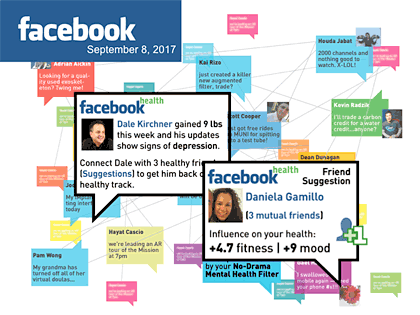Future Now
The IFTF Blog
Contagion Health
Imagine you log into your Facebook* account on September 8, 2017. You see a scattering of updates from your friends—somebody accidentally swallowed their mobile phone, and somebody else is complaining that none of the 3000 shows that premiered on YouTube this season is any good.

As expected, Facebook has released all sorts of new features since 2011. You are using an add-on service called Facebook Health, and you see that Dale Kirchner has gained 9 pounds, and that the content of his updates suggest he may be experiencing depression. Facebook Health is recommending that you “friend” Daniela Gamillo because she will be a positive influence on both your desire to stay physically active and on your mood. You are also using a new filtering service, which allows you to block certain updates depending on the content, so you don’t get a post from your friend Eugene’s post that, according to computational algorithm, may have a negative effect on your mental health.
What is this Artifact from the Future, designed by Institute for the Future’s Jason Tester, conveying about the future?
It’s one potential response we can imagine as the forecast, Contagion Health, plays out over the next decade. Contagion Health, which sits at the intersection of networks and practices on Health Horizons’ Map on the Future of Science, Technology, and Well-being 2020 Forecast, identifies the improved understanding of the effects our social networks, both online and in the real world, will have on how we manage our health. Thanks to advances in computational modeling and complex analysis tools, researchers are able to simulate how networks of people function as levers to improve or worsen the health and well-being of those around them.
Using these new tools, researchers such as Dr. James Fowler and Dr. Nicholas Christakis are examining and experimenting with how public health information could be extracted from social networks. Take the research on flu epidemics they published in 2010. After tracking the social networks of Harvard undergrads, they determined that, as expected, the nodes identified as social butterflies do indeed get the flu earlier than the randomly selected nodes. Less clear, prior to this type of social network research, however, is just how much earlier those situated more centrally in a network contract an infectious disease. The researchers argue that by watching flu reports among the highly connected in any social network, a flu outbreak could be predicted up to 46 days before its peak in daily incidence occurs in the population as a whole.
Obviously, it’d be difficult to map out social networks for every person or every patient. But Dr. Christakis and Dr. Fowler are arguing that, with the aide of advanced visualization and network analysis tools, we can identify the sentinel nodes in a network, and by they tracking them, we may be able to curb an outbreak before it spreads.
The forecast of Contagion Health does not only describe the precise understanding we’ll have about how an infectious disease spreads through a network. It’s also a new understanding of how health habits and information spread. As Dr. Fowler and Dr. Christakis argue, “The method could in principle be generalized to other biological, psychological, informational, or behavioral contagions that spread in networks.”
This connection between health and our social environment is not new. Since 1948, the Framingham Heart Study in Massachusetts has been researching cardiovascular disease by following a large group of participants—how they interact and what that means for the progression of disease. Through this study and many others, researchers are finding that not only do we rely on social communities for emotional encouragement and support in achieving our health goals, but our social networks are critical influencers on our health behaviors and attitudes. This includes both the behaviors historically attributed to peer pressure, such as whether or not we smoke, as well as our attitudes towards vaccinations, our perceptions on what is trusted health information, and our knowledge about nutrition and physical exercise. In other worlds, our social networks tend to serve as amplifiers, enhancing or intensifying our existing health behaviors.
So while we’ve known that our social surroundings are important determinants of our health, the new tools and advances in technology will lead to innovations in social interventions—treating people as participants in a network instead of disconnected individuals. Over the next decade, individuals and companies alike will use computational modeling to simulate networks and design network-based interventions. We’ll be able to identify clusters of people with similar health profiles to extrapolate health risks and intervene at the level of the network, and we can anticipate that this improved understanding of exactly how networks inform and influence our health will lead to next generation social health recommendation engines.
Social interventions and other new approaches to manage population health will not emerge without controversy—imagine if we vaccinated citizens based on the level of centrality or transitivity in a network! But the forecast suggests that an improved literacy about network behaviors will lead to far more than Groupon coupons and flashmobs at the mall.
*or whatever social networking site may be popular in 2017...



